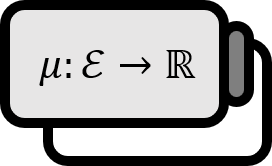Maximal Lemma
Theorem1
Let’s call a collection of open balls at $\mathbb{R}^n$ given $\mathcal{B}$. Let’s say $U=\bigcup \limits_ { B\in \mathcal{B}} B$. Then, for some constant $c \lt m (U)$, there exist a finite number of mutually disjoint $B_{j} \in \mathcal{B}$ that satisfy the following condition.
$$ \dfrac{c}{3^{n}} \lt \sum \limits_{j=1}^{k} m(B_{j}) $$
Here, $m$ is the $n$-dimensional Lebesgue measure.
Description
Actually, this theorem is not officially named the maximal lemma, but it is conveniently named because it is used as a lemma in the maximal theorem.
It guarantees that there necessarily exists a finite set ${B_{j}}$ whose measure values are between $m(U)$ and $c/3^{n}$.
Proof
First, there exists a compact set $K \subset U$ that satisfies $c< m (K) \le m (U)$2. Then, by the definition of compact, there exists a sub cover $\left\{ A_{i} \right\}_{1}^l$ of $K$. Now, among these, let’s call the largest3 one $B_{1}$. Let’s call the largest among $A_{i}$ that are disjoint with $B_{1}$, $B_2$. And let’s call the largest one among $A_{i}$ that are disjoint with both $B_{1}$ and $B_2$, $B_{3}$. In this way, we can construct a finite collection $\left\{ B_{j} \right\}$.
For $A_{i}$ not included in $\left\{ B_{j} \right\}$, there exists $j$ that satisfies $A_{i} \cap B_{j} \ne \varnothing$. Moreover, for the smallest $j$ among those $j$s4, the radius of $A_{i}$ can be at most $B_{j}$. That means, it cannot be larger than the radius of $B_{j}$. Otherwise, $A_{i}$ would have taken the name of $B_{j}$ when constructing $\left\{ B_{j}\right\}$5.
Now, let’s call $B^{\ast}_{j}$ an open ball with the same center as $B_{j}$ but with a radius three times larger. Then, as $A_{i}$ is not larger than $B_{j}$ in radius and overlaps with $B_{j}$, it must be included in $B^{\ast}_{j}$. Hence, $K \subset \bigcup A_{j} \subset \bigcup B^{\ast}_{j}$ is true.
$$ \begin{align*} c \lt m (K) & \lt m \left( \bigcup \nolimits_{1}^k B^{\ast}_{j}\right) \\ &= \sum \limits_{1}^{k} m (B^{\ast}_{j}) \\ &= \sum \limits_{1}^{k} 3^{n} m (B_{j}) \end{align*} $$
$$ \implies \dfrac{c}{3^{n}} \lt \sum \limits_{j=1}^{k} m(B_{j}) $$
■
Definition
For every bounded measurable set $K \subset \mathbb{R}^n$,
$$ \int_{K} |f(x)|dx<\infty $$
a function $f : \mathbb{R}^n \rightarrow \mathbb{C}$ that satisfies this is said to be locally integrable, and the set of locally integrable functions is denoted as $L^{1}_{\mathrm{loc}}$.
Let $f \in L^1_{\mathrm{loc}}$, $ x\in \mathbb{R}^n$, and $r>0$. Let’s denote the open ball with center $x$ and radius $r$ as $B(r,x)=B_{r}(x)$. Then, on $B_{r}(x)$, the average value of function $A_{r}f(x)$ of $f$ is defined as follows.
$$ A_{r} f(x) := \frac{1}{m \big( B_{r}(x) \big)} \int _{B_{r}(x)}f(y)dy $$
$A_{r}$ is called an averaging operator.
